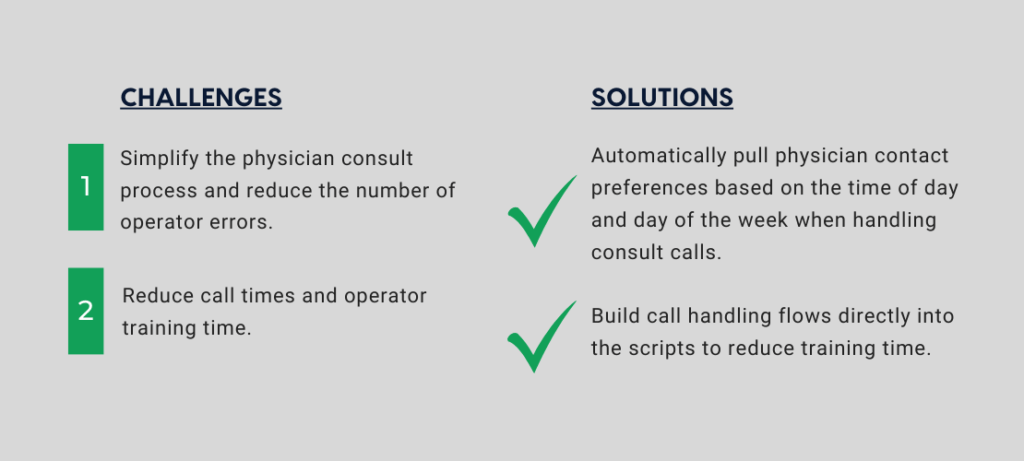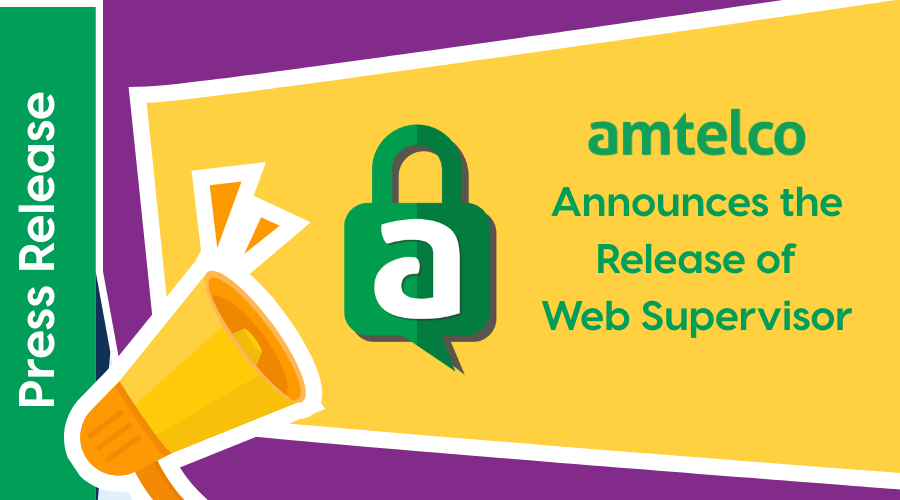A hospital in the Midwest with 476 beds, several outpatient locations, and employs 620 medical staff members and an additional 2,800 caregivers, has a call center that typically answers almost 90,000 calls each month. They handle a wide variety of requests from callers, including calls for patients and hospital employees, answering services for physicians, codes and alarms, prescription refills, remote receptionist, appointments, and scheduling.
When the hospital upgraded its call center system to Amtelco’s solution, the new software gave them innovative scripting capabilities, allowing them to script various calls to their call center. The platform also significantly enhanced their organization’s directories, on-call scheduling, and reporting capabilities. After upgrading, the major advantages were “fewer errors, happier physicians, and being better able to accommodate physicians and their busy lives,” according to their Systems Analyst II.
Significant Call Handling and Training Improvements
One of the most significant benefits scripting brings to the hospital call center is the reduced training time for operators. Before scripting, training a new operator involved explaining how each type of call needed to be handled and any special requirements for some of the physicians. This process could take up to a month for new operators to become familiar with all the details.
Now, that type of information is built directly into the scripts, which has reduced training time for a new operator to about one day. The Systems Analyst II said, “Now we can pretty much pull anyone in, sit them down, and off they go.”

They use script templates to speed the process of building scripts and setting up new physician accounts. “It took about a month to do some basic work, with a few tricks here and there. I feel confident saying there wasn’t a whole lot I couldn’t handle after only a couple of months,” stated the Systems Analyst II. “As soon as we started using scripts, call time was shorter, errors were fewer, and training was better. It was just all around more efficient.”
The primary reason scripting reduces errors and speeds call processing is because scripting does all the work in the background. The scripts automatically determine how to contact the physician based on the current day and time. “They don’t have to think outside of the box. It makes calls faster, and it improves efficiency. There are fewer errors this way, and everything is done right there for you. You follow your screen – top to bottom, left to right,” said the Systems Analyst II.
Simplified and Unified Communication Keeps Physicians Happy
When working with new physicians, the Systems Analyst II collects their basic office information and contact information and asks how they want their calls handled on weekdays, nights, and weekends. New physicians often challenge her, asking if the call center can provide particular services. “They’ll say, ‘You can do that?!’ People are amazed at our technology and what we can do.” She continued, “Never once have I told someone I can’t do that – because I actually can.”
Prior to using scripting, consults were the most challenging type of call for the operators because each doctor has their own way in which they want consult calls handled. Now that they are using scripting, “We get all of the necessary information from the caller, such as where the patient is, and what the consult is for, and then the system automatically pulls in the doctor’s contact preferences (home phone, cell, or pager) based on the time of day and day of the week. Before scripting, that was a little bit of a bear. There were lots of errors,” explained the Systems Analyst II. “All the work is done behind the scenes. We can page groups as well as individuals. So, it’s one button that does all the work. And then in the background, we’re getting all of these people contacted, all at the same time.”

The platform is also integrated into the health system’s HL7 patient information database. “We can pull information based on each hospital, and that eliminates spelling errors, date of birth errors, etcetera. It speeds up the call time, pulls in all that information very quickly, and then as soon as we select the ‘Next’ button, the script handles the rest,” said the Systems Analyst II.
Continuous Quality Improvement with Special Scripts and Reporting
Ensuring everything is current and updated can be a challenge for any organization. The hospital has a unique script to assist them. The Systems Analyst II explained, “We created a script within our department for operators to help report things and submit ideas for changes or updates. The operators really appreciate it. It’s all very neat in one account, and I don’t have to go anywhere else for that information.”
Hospital call centers generate a lot of data. Custom reports about this data can be done in real-time or scheduled in advance for billing, agent evaluation, call stats, system usage, and more. Measure and improve operator performance using relevant statistics and leverage metrics to streamline agent workflows and contribute to a frictionless caller experience.
Reports can also help protect organizations in litigious situations. Calls, messages, screen captures, and more can be recorded, tracked, time-stamped, stored, and recalled if a situation develops where an interaction needs to be reviewed.
Determining what happened on a particular call is very easy. She continued, “I use a lot of the reports, trying to investigate calls. I would say that’s a huge perk now. Using reports, I can tell what happens with calls – if there is an operator error or if someone hung up, etc. I feel like Inspector Gadget! It’s really great. I love it.”
When talking to others about upgrading to Amtelco, the Systems Analyst II typically asks what their most challenging type of call is and then tells them how scripting can help make those calls so much easier. “The biggest thing is that nothing is impossible,” she said. “It looks better, it’s cleaner, it’s neater, it’s just very nice all around.”



